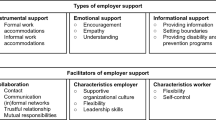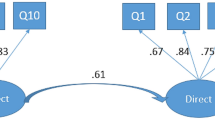Abstract
Introduction Timely and appropriate accommodations can help employees who experience disabilities stay at work instead of exiting the labor force. Employers can play a critical role in connecting such workers with the accommodations they need. This qualitative study seeks to inform policy makers who want to improve workforce retention outcomes by uncovering factors that affect whether employers provide accommodations to, and ultimately retain, employees with disabilities. Methods We conducted semistructured interviews with a convenience sample of human resources professionals in 14 Arkansas-based employers, yielding detailed information on 50 cases in which an employee developed or disclosed a disability. We analyzed the interviews using a grounded theory approach and compared cases to identify key themes emerging across subgroups of cases. Results Two organization-level factors and four employee-level factors influenced employers’ efforts to accommodate and retain employees with disabilities: employer resources; employers’ communication with the employee and other stakeholders; employee tenure; employee work performance; active/sedentary nature of employee role; and the severity and type of employees’ health conditions. Conclusions Consistent with prior literature, employers with greater access to resources and better ability to communicate generally made greater effort to accommodate and retain employees with disabilities. However, employers in the study did not deploy these resources and processes consistently when making decisions about whether and how to provide accommodations to workers with disabilities; employee-level characteristics affected their actions. Policy makers should consider intervention approaches that reach workers who may be overlooked by employers with scarce resources.

Similar content being viewed by others
Notes
Workplace accommodations are defined as adjustments to a job, work environment, or work process that enable individuals with disabilities to apply for a job, perform job functions, or have equal access to benefits available to other individuals in the workplace [24]. Respondents discussed providing employees with a variety of accommodations, and some also mentioned the provision of services through Employee Assistance Plans (EAPs), which are usually considered a support rather than an accommodation. However, for clarity and readability, we use the term “accommodations” to refer to all work adjustments, including EAP services, to address issues that interfere with work performance.
ARS’s SAW/RTW program is designed to support employers throughout the state of Arkansas in assisting employees that experience injury or illness in remaining at work or returning to work. Similar programs in other states include Alabama’s Retaining A Valued Employee (RAVE) program and South Carolina’s Job Retention Services (JRS) program.
We initially planned to interview five employers from the convenience sample provided by ARS and draw a comparison sample of nine employers with similar geographic context, industries, and firm sizes through other sources such as a professional society. The industries that we initially targeted were finance and insurance, manufacturing, educational services, health care and social assistance, accommodation and food services, and civic and social organizations. We modified this approach when we decided against explicitly comparing ARS and non-ARS employers, and recruited from a wider range of industries, including transportation/warehousing and media.
There was one exception to having both interviewers present during the in-person interviews: an organization requested to have two employees interviewed, so we conducted simultaneous, separate interviews, each with one interviewer only. We merged the two interview transcripts into one file for analysis. We consider this one in-person interview in two parts.
EAPs provide “professional services provided primarily by licensed clinicians offering problem identification and/or assessment, referral, short-term counseling, treatment coordination, and follow-up to employees affected by a variety of personal concerns” [25].
JAN is a free online resource and consulting service for employers and individuals with disabilities funded by the U.S. Department of Labor’s Office of Disability Employment Policy. JAN provides information on accommodations and disability employment issues, such as an accommodations database detailing options by health condition and the ability to request technical assistance from JAN consultants regarding job accommodations and the ADA.
Two other employers expressed mixed sentiments about the effect of performance on attempts to accommodate. For example, after noting that an employee’s good performance motivated her to retain the employee, Christina Vaughan said that she would also work to retain a “marginal” employee (though she made no note of how she would handle a low-performing employee).
In case 24, an employee at a bank worked from home during recovery from rotator cuff surgery. In case 49, a research faculty member with back issues was permitted to work from home when her back issue flared up.
References
Hollenbeck K. Promoting retention or reemployment of workers after a significant injury or illness. Washington, DC: Center for Studying Disability Policy; 2015.
Social Security Administration. Annual statistical report on the Social Security Disability Insurance program, 2016. SSA Publication No. 13-11826. Washington, DC: Social Security Administration; 2017.
Schimmel JH, Stapleton D. The financial repercussions of new work-limiting health conditions for older workers. J Health Care Org Provis Finance. 2012;49(2):141–163.
Anand P, Ben-Shalom Y. The promise of better economic outcomes for workers with musculoskeletal conditions. New York: Roosevelt House Public Policy Institute at Hunter College; 2017.
Ben-Shalom Y, Burak H. The case for public investment in stay-at-work/return-to-work programs. Center for Studying Disability Policy. 2016.
Wickizer T, et al. Improving quality, preventing disability and reducing costs in workers’ compensation healthcare: a population-based intervention study. Med Care. 2011;49(12):1105–1111.
Linton SJ, et al. Early workplace communication and problem solving to prevent back disability: results of a randomized controlled trial among high-risk workers and their supervisors. J Occup Rehabil. 2016;26(2):150–159.
Hoefsmit N, et al. Intervention characteristics that facilitate return to work after sickness absence: a systematic literature review. J Occup Rehabil. 2012;22(4):462–477.
Franche RL, et al. Workplace-based return-to-work interventions: optimizing the role of stakeholders in implementation and research. J Occup Rehabil. 2005;15(4):525–542.
Brooks RA, et al. Perceived barriers to employment among persons living with HIV/AIDS. AIDS Care. 2004;16(6):756–766.
Shier M, et al. Barriers to employment as experienced by disabled people: a qualitative analysis in Calagary and Regina, Canada. Disabil Soc. 2009;24(1):63–75.
Ameri M, et al. The disability employment puzzle: a field experiment on employer hiring behavior (No. w21560). National Bureau of Economic Research. 2015.
Kaye S, et al. Why don’t employers hire and retain workers with disabilities? J Occup Rehabil. 2011;21(4):526–536.
McFarlin D, et al. Integrating the disabled into the work force: a survey of Fortune 500 company attitudes and practices. Empl Responsib Rights J. 1991;4(2):107–123.
MacEachen E, et al. Systematic review of the qualitative literature on return to work after injury. Scand J Work Environ Health. 2006;32(4):257–269.
Cornelius LR, et al. Prognostic factors of long term disability due to mental disorders: a systematic review. J Occup Rehabil. 2011;21(2):259–274.
Kristman VL, et al. Supervisor and organizational factors associated with supervisor support of job accommodations for low back injured workers. J Occup Rehabil. 2017;27(1):115–127.
Williams-Whitt K, et al. A model of supervisor decision-making in the accommodation of workers with low back pain. J Occup Rehabil. 2016;26(3):366–381.
McGuire C, et al. Supervisor autonomy and considerate leadership style are associated with supervisors’ likelihood to accommodate back injured workers. J Occup Rehabil. 2015;25(3):589–598.
Bernard HR. Research methods in anthropology: qualitative and quantitative approaches. 3rd ed. Walnut Creek: Alta Mira Press; 2002.
Strauss AL, Corbin JM, editors. Grounded theory in practice. Thousand Oaks: Sage; 1997.
Christian J, et al. A community-focused health & work service (HWS). In: McCrery J, Pomeroy E, editors. SSDI solutions: ideas to strengthen the social security disability insurance program. West Conshohocken: Infinity Publishing; 2016.
Stapleton D, Ben-Shalom Y, Mann D. The employment/eligibility service system: a new gateway for employment supports and social security disability benefits. In: McCrery J, Pomeroy E, editors. SSDI Solutions: ideas to strengthen the social security disability insurance program. West Conshohocken: Infinity Publishing; 2016.
Department of Labor. Accommodations. 2017. https://www.dol.gov/odep/topics/Accommodations.htm.
Younger B. Employee assistance programs. The Encyclopedia of Clinical Psychology. 2015. https://doi.org/10.1002/9781118625392.wbecp434.
Acknowledgements
Thank you to Rayna Thornton and Stephanie Rosenbluth for research assistance.
Funding
Funding for this study was provided by the Research and Training Center on Employment Policy and Measurement at the University of New Hampshire, which is funded by the National Institute for Disability, Independent Living, and Rehabilitation Research, in the Administration for Community Living, at the U.S. Department of Health and Human Services (DHHS) under cooperative agreement 9ORT5037-02-00. The contents do not necessarily represent the policy of DHHS and you should not assume endorsement by the federal government (EDGAR, 75.620 (b)).
Author information
Authors and Affiliations
Corresponding author
Ethics declarations
Conflict of interest
Alix Gould-Werth, Katherine Morrison, Yonatan Ben-Shalom declare that they have no conflict of interest.
Ethical Approval
All procedures performed as part of this study were approved by the University of New Hampshire Institutional Review Board for the Protection of Human Subjects in Research under IRB #6600. This article does not contain any studies with animals performed by any of the authors.
Informed Consent
Informed consent was obtained from all individual participants included in the study.
Appendix: Interview Protocols
Appendix: Interview Protocols








Rights and permissions
About this article
Cite this article
Gould-Werth, A., Morrison, K. & Ben-Shalom, Y. Employers’ Perspectives on Accommodating and Retaining Employees with Newly Acquired Disabilities: An Exploratory Study. J Occup Rehabil 28, 611–633 (2018). https://doi.org/10.1007/s10926-018-9806-6
Published:
Issue Date:
DOI: https://doi.org/10.1007/s10926-018-9806-6




